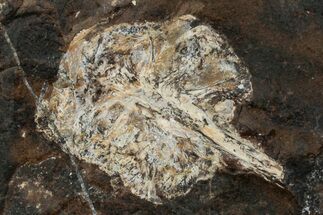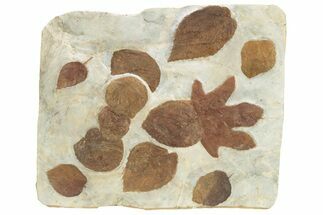This Specimen has been sold.
Fossil Ginkgo Leaves with Partial Winged Walnut Fruit - North Dakota
These are two beautiful fossil Gingko leaves (Ginkgo cranei) that're associated with a partial winged walnut fruit (Cyclocarya brownii) from the Sentinel Butte Formation of North Dakota. It is finely detailed and the light preservation contrasts well against the dark orangish-brown rock. There is an additional fossil of what appears to be a cluster of small fruit, however the fossil is unidentified.
During this time in the Paleocene epoch, the Ginkgo genus was only represented by a single polymorphic species, formerly described as Ginkgo adiantoides. In 2012, the taxon Ginkgo cranei was assigned in place of Ginkgo adiantoides. This species was distributed in much of the northern regions of North America, which had a hot, humid climate at the time. Its leaves were virtually indistinguishable from modern-day Ginkgo biloba. These species of Ginkgo went extinct approximately 7 million years ago.
The walnut family of plants, Juglandaceae, includes walnuts, hickories, and pecans and has one of the best-documented fossil records in the northern hemisphere. The oldest modern genus, Cyclocarya, which is today restricted to a single extant species in China, first appears in the late Paleocene (57 million years ago) of North Dakota, USA. Unlike walnuts and pecans that produce edible fruits dispersed by mammals, Cyclocarya fruits are small nutlets surrounded by a prominent circular wing. Because of these wings, they might be assumed to be wind-disperse, but their radial symmetry does not have the aerodynamic qualities typical of wind-dispersed fruits, and may have been dispersed by water.
A paper describing these fruits in depth is linked below.
Cyclocarya brownii from the Paleocene of North Dakota, USA
A paper describing these fruits in depth is linked below.
Cyclocarya brownii from the Paleocene of North Dakota, USA
SPECIES
Ginkgo cranei & Cyclocarya brownii (Fruit)
AGE
LOCATION
Morton County, North Dakota
FORMATION
Sentinel Butte Formation
SIZE
1.7" longest leaf on 4.6 x 2.3" rock
CATEGORY
ITEM
#156255
We guarantee the authenticity of all of our specimens.
 Reviews
Reviews












